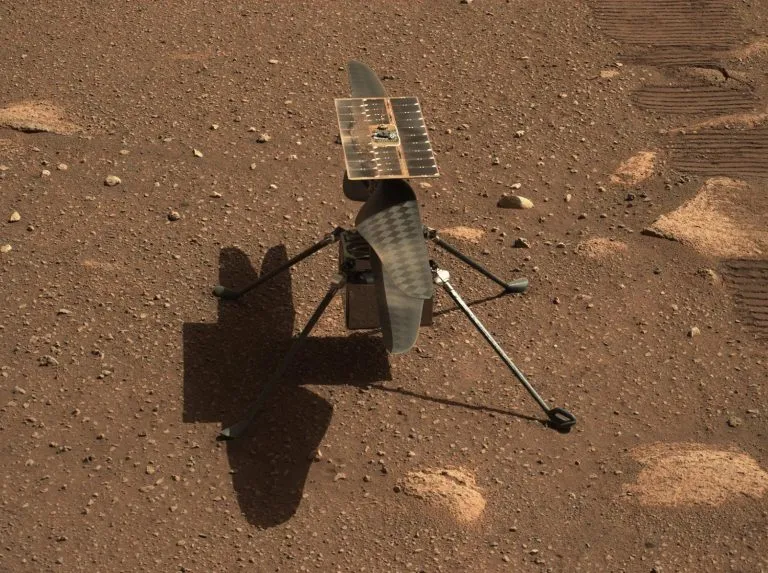Although the operation of NASA's ingenuity Mars helicopter exceeded expectations, proving that the helicopter's power control flight on Mars is possible, and has achieved incredible success everywhere, the upcoming Martian winter brings additional challenges. Every solar day may be the last day of ingenuity**

In the winter on Mars, the solar array of ingenuity Mars helicopter may be insufficient in maintaining battery charging due to less sunlight reaching the array. It is believed that it has suffered from battery power failure at night, and the low voltage caused the electronic device to reset. It is also possible that the heater does not have enough power to keep the electronic equipment within its safe temperature range. This cold cycle every night may cause the electronics to fail.
As detailed in a recent article, the NASA ingenuity team lost communication with ingenuity on the downlink on May 3 (SOL 427) and May 4 (SOL 428) for the first time during their year long extended mission. After a week of anomaly investigation, two sun days dedicated to data collection, and the efforts of the perseverance and ingenuity operation teams, the team is pleased to report that they have re established reliable communication with ingenuity. Based on all available telemetry data, the helicopter looks healthy and the team has restored the modified operation mode. Assuming that the winter re commissioning activities are nominally completed, ingenuity's 29th flight may take place in the next few solar days.
Ingenuity's telemetry confirmed that the loss of communication was due to insufficient battery state of charge (SOC) at night, which led to the task clock reset of ingenuity team. This daily SOC deficit may persist during Martian winter (until September / October).
Such challenges are expected: in addition to the five flights originally planned, after hundreds of flights and dozens of flights, the solar helicopter is in an unknown field. The team is now operating well beyond their original design limitations. Historically, Mars has been very challenging for spacecraft (especially solar powered spacecraft). Every solar day may be the last day of ingenuity.

The following is a summary of the abnormal investigation of ingenuity team in the past two weeks, their elevated winter risk situation, and the possible path of ingenuity in winter and beyond.
Sol 427 and 428 lost communication
In late autumn / early winter on Mars, the ingenuity team has reached the point where ingenuity can no longer support the energy demand of nominal operation. From the evening of sol 426, the ingenuity team believed that the helicopter began to experience nighttime battery power failure (battery voltage drop), which would reset the electronic equipment. Due to the seasonal decrease of available solar energy, the increase of dust density in the air and the decrease of temperature, the energy demand to keep electronic equipment powered and warm at night has exceeded ingenuity's available energy budget.
The following is a map of the environmental conditions of the jezro crater. The black line is a climate model of the annual dust density of Mars (called "tau"), and the green dotted line shows the expected daily sunshine (the amount of solar light reaching the solar panels). The Martian year, which is now at the peak of tau, plus the decline of sunlight. This figure does not show the additional trend of daily average temperature decrease, which also increases the energy demand of ingenuity. The ingenuity team expects to maintain around sol 600 in this challenging winter energy model.

In winter, the ingenuity team hopes that the battery SOC will drop to a low enough level every night:
- Cold cycle components: the heater thermostat of ingenuity team can no longer maintain the battery (and surrounding electronic devices) at its programmed set point (e.g. minus 25 ° C). Therefore, they expect the ambient temperature of ingenuity's electronic equipment at night to reach about minus 80 ° C. Effect 1: this cold cycle will bring a lifetime risk to our electronic components every night.
- Clear task clock: the battery no longer supports ingenuity's voltage regulator and task clock. This nighttime outage resets (or clears) the task clock. Effect 2: every morning, when ingenuity warms up, charges the exhausted battery, and tries to turn on its computer, it starts according to an error alarm plan that is not synchronized with the perseverance.
When perseverance tried to communicate with ingenuity in the morning of sol 427 and 428, ingenuity did not respond because it "woke up" at the wrong time. The response of the team was to try to communicate with ingenuity during a dislocation alarm window of ingenuity by uplink the all sol search activity to the helicopter base station (HBS) on the "perseverance". The activity was successful.
From sol 429 and every subsequent sol (except sols 444 and 445, which do not include helicopter activities), the team keeps in touch with ingenuity every day, and uses similar morning search activities when they think it is most likely to happen. Ingenuity will be fully charged to try to start its electronic equipment. These morning search activities reprogram the helicopter's mission clock during each sol, which enables additional scheduled activities to utilize the actually available energy during that sol. At present, the team reaches the sunset state with about 68% SOC. It is estimated that at least 70% of the power is required to keep all equipment powered overnight. Once we reach the winter solstice (SOL 500 in July), the team expects the SOC deficit of 2% to increase to 7%, and then the situation will begin to improve.
So far, all telemetry data show that ingenuity is healthy and shows no signs of damage due to the overnight cold cycle. Getting up early and evening activities are the new normal of the team in the near future.
Risk situation in winter
The latest model of ingenuity team shows that no matter what modification is made to the night thermostat strategy, it is extremely challenging or even impossible to keep the electronic core module (ECM) components warm overnight and within its nominal temperature range. Although component failure has been their risk since the deployment of the mobile station, this risk has been amplified. ECM components are usually kept warm overnight by a battery heater (usually set to minus 4 ° C, minus 15 ° C or minus 25 ° C). The team expects that the ECM components are now being thermally cycled to an ambient overnight temperature of minus 80 ° C. The team did conduct limited ECM component testing, indicating that some components may survive the winter, but they could not predict how the entire ECM would operate throughout the winter.
Winter operation and later
In view of the high-risk situation, the ingenuity team focused on giving priority to the data downlink from ingenuity to HBS in the last few solutions. Before copying all unique data from ingenuity to HbS, the team has some Hei to HbS transfer activities. Specifically, they are replicating the flight performance logs, electronic logs and high-resolution color images of the last eight flights still on ingenuity.
After transferring all key logs, the team will enter the re commissioning phase, during which they will re-establish the flight readiness of ingenuity in view of their ongoing night cold cycle. As in the technical demonstration phase, the team will spin at high speed before starting the flight. If ingenuity receives a health certificate, they will prepare for a short-range attack to the southwest in 29 flights. The flight will improve the radio link in the next four to six months, while the perseverance will sample in the River Delta.
Meanwhile, the ingenuity flight software team will prepare a series of upgrades to enable advanced navigation functions. These new capabilities will help ingenuity climb the River Delta and continue its mission as a forward scout for the perseverance.
next step
The perseverance and ingenuity operations teams have done a great job in rebuilding reliable communications with ingenuity. As of sol 446, the team has transferred about 3500mb) of data from ingenuity to HbS. About 400 MB of non critical log and image data remaining on ingenuity will be randomly transmitted, and the team will continue to re debug this week. If the telecommunication link between perseverance and ingenuity remains stable and ingenuity receives a health bill, the team hopes to perform the 29th flight in the next few suns.